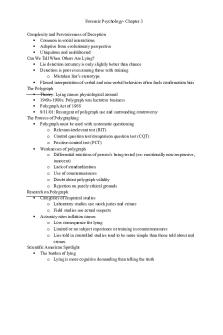Chapter 3 - Summary Forensic Psychology PDF

| Title | Chapter 3 - Summary Forensic Psychology |
|---|---|
| Author | Lynton Lam |
| Course | The Psychology of Crime and Punishment |
| Institution | The University of Western Ontario |
| Pages | 2 |
| File Size | 45.4 KB |
| File Type | |
| Total Downloads | 5 |
| Total Views | 185 |
Summary
Chapter summary...
Description
Chapter 3 Learning Objectives • • • • • •
Describe the Reid model of interrogation Outline potential problems with the Reid model Differentiate among false, retracted and disputed confessions Define the types of false confessions Explain police use of criminal profiling and outline potential problems with profiling Explain what geographic profiling is and how it is used by police
Chapter 3 Summary 1. The primary goal of many police interrogations in North American is to obtain a confession from the suspect. Police officers sometimes use the Reid model of interrogation to accomplish this goal. This model advocates the use of psychologically based interrogation tactics to break down a suspect’s resistance to telling the truth. The tactics used in the Reid model of interrogation can be broken down into minimization and maximization techniques. 2. The three potential problems with the Reid model of interrogation are (1) the inability of police officers to accurately detect deception, (2) biases that result from presuming a suspect is guilty, and (3) an increased likelihood that suspects will make false confessions. 3. False confessions must be differentiated from retracted confessions and disputed confessions. A false confession is one that is either intentionally fabricated or is not based on actual knowledge of the facts in a case. A retracted confession is simply an individual’s statement that his or her confession is false. A disputed confession is one that is disputed at trial, often because of a legal technicality or because the suspect disputes the confession was ever made. 4. There are three types of false confessions, each having its own set of vulnerability factors. Voluntary false confessions occur when someone voluntarily confesses to a crime he or she did not commit without any elicitation from the police. Coerced-compliant false confessions are those in which the suspect confesses to a crime, even though the suspect is fully aware that he or she did not commit it. Coerced-internalized false confessions consist of individuals confessing to a crime they did not commit—and subsequently coming to the belief they committed the crime— usually after they are exposed to highly suggestible questions. 5. Criminal profiling is sometimes used by the police in serial crime investigations. They use it for prioritizing suspects, developing new lines of inquiry, setting traps to flush out offenders, determining whether an offender’s actions should be taken seriously, giving advice on how to interrogate suspects, and developing courtroom strategies. Despite its use, criminal profiling is often criticized. One major criticism centres on the lack of a strong theoretical base underlying the approach. A second criticism relates to the lack of empirical support for certain profiling assumptions. A third criticism is that many profiles contain ambiguous information and this may cause problems when police officers are asked to interpret the profile. A fourth criticism is that professionally trained profilers may be no better than other individuals at constructing accurate profiles.
6. Another common form of profiling is geographic profiling, which is defined as any technique that uses crime scene locations to predict the most likely area where the offender resides. This form of profiling is often used to prioritize suspects, by rank ordering them based on the proximity of their residence to the predicted home location....
Similar Free PDFs

Forensic Psychology Chapter 3
- 3 Pages

Forensic Psychology Chapter 4
- 4 Pages

Forensic Psychology
- 4 Pages

Forensic psychology modules
- 17 Pages

Historyof Forensic Psychology
- 10 Pages

2 Forensic Psychology Notes
- 45 Pages

Forensic Psychology Lecture 1
- 7 Pages

Forensic Psychology - Lecture 22
- 4 Pages

Forensic Psychology- Content Unit
- 66 Pages

Forensic Psychology Lecture Notes
- 78 Pages

Forensic Chapter 3 Test Bank
- 20 Pages
Popular Institutions
- Tinajero National High School - Annex
- Politeknik Caltex Riau
- Yokohama City University
- SGT University
- University of Al-Qadisiyah
- Divine Word College of Vigan
- Techniek College Rotterdam
- Universidade de Santiago
- Universiti Teknologi MARA Cawangan Johor Kampus Pasir Gudang
- Poltekkes Kemenkes Yogyakarta
- Baguio City National High School
- Colegio san marcos
- preparatoria uno
- Centro de Bachillerato Tecnológico Industrial y de Servicios No. 107
- Dalian Maritime University
- Quang Trung Secondary School
- Colegio Tecnológico en Informática
- Corporación Regional de Educación Superior
- Grupo CEDVA
- Dar Al Uloom University
- Centro de Estudios Preuniversitarios de la Universidad Nacional de Ingeniería
- 上智大学
- Aakash International School, Nuna Majara
- San Felipe Neri Catholic School
- Kang Chiao International School - New Taipei City
- Misamis Occidental National High School
- Institución Educativa Escuela Normal Juan Ladrilleros
- Kolehiyo ng Pantukan
- Batanes State College
- Instituto Continental
- Sekolah Menengah Kejuruan Kesehatan Kaltara (Tarakan)
- Colegio de La Inmaculada Concepcion - Cebu




